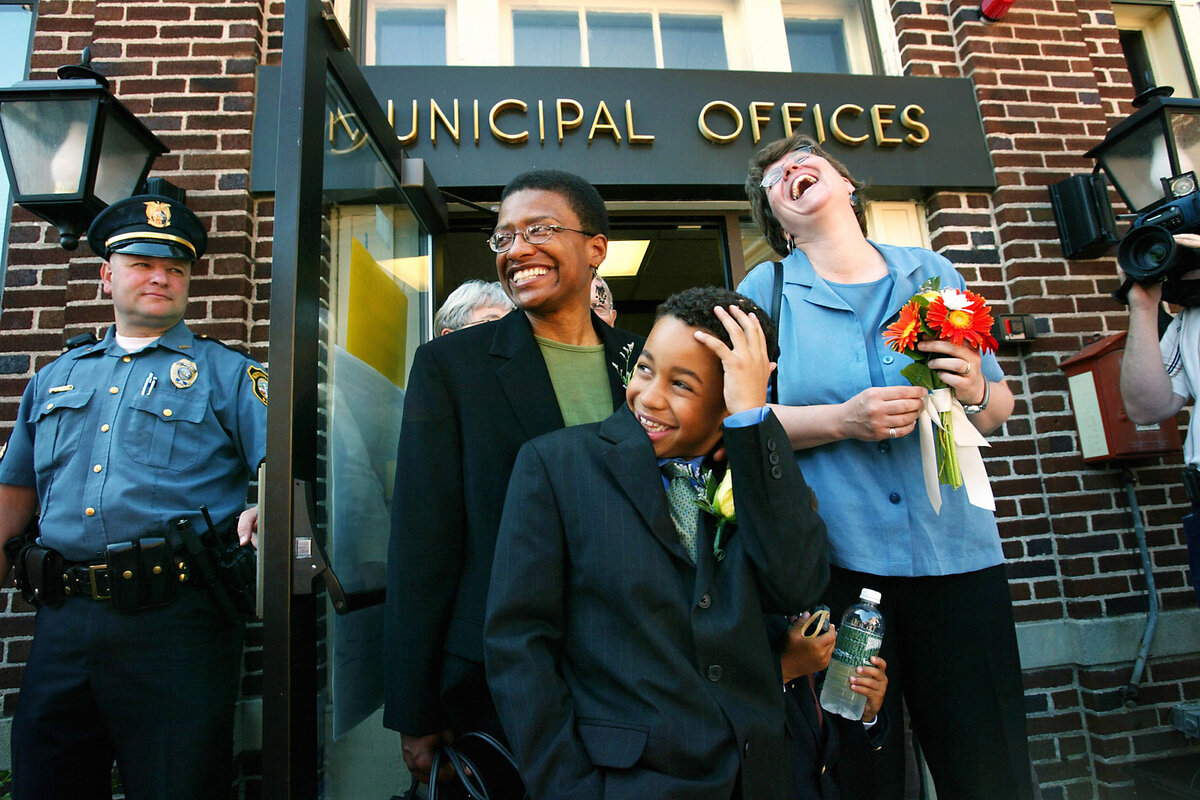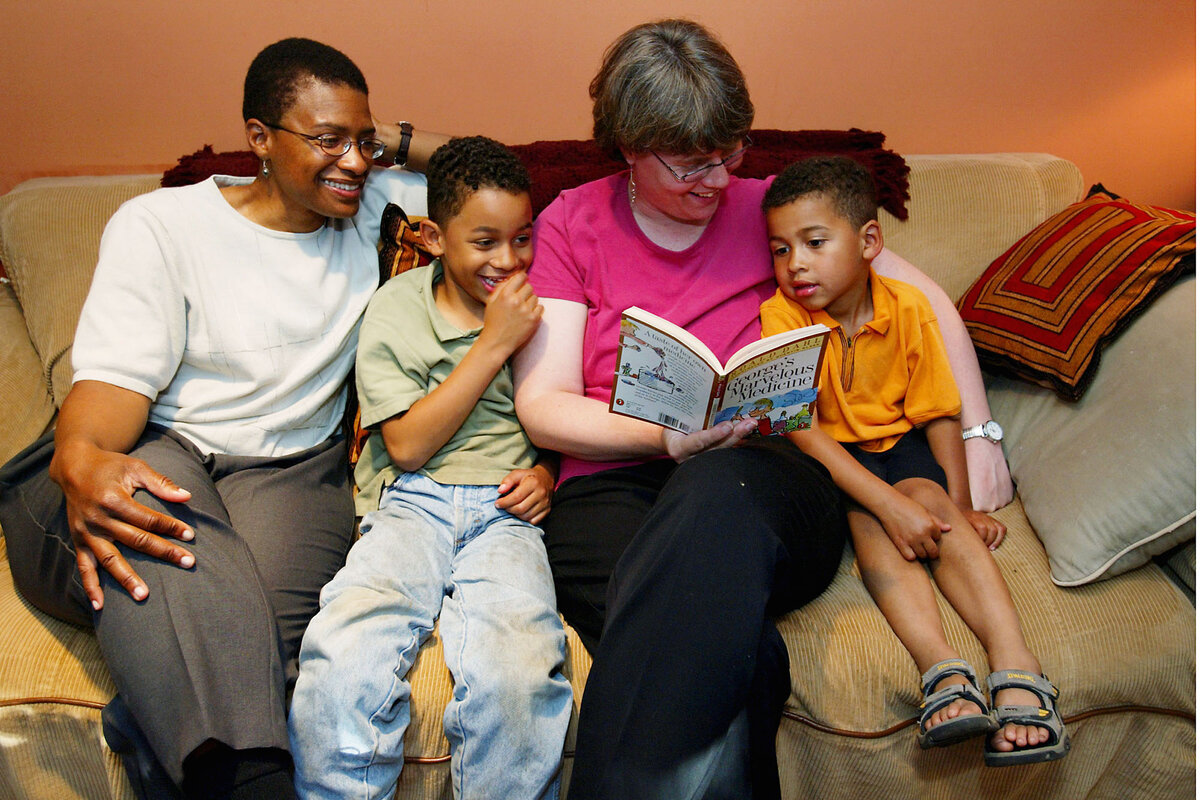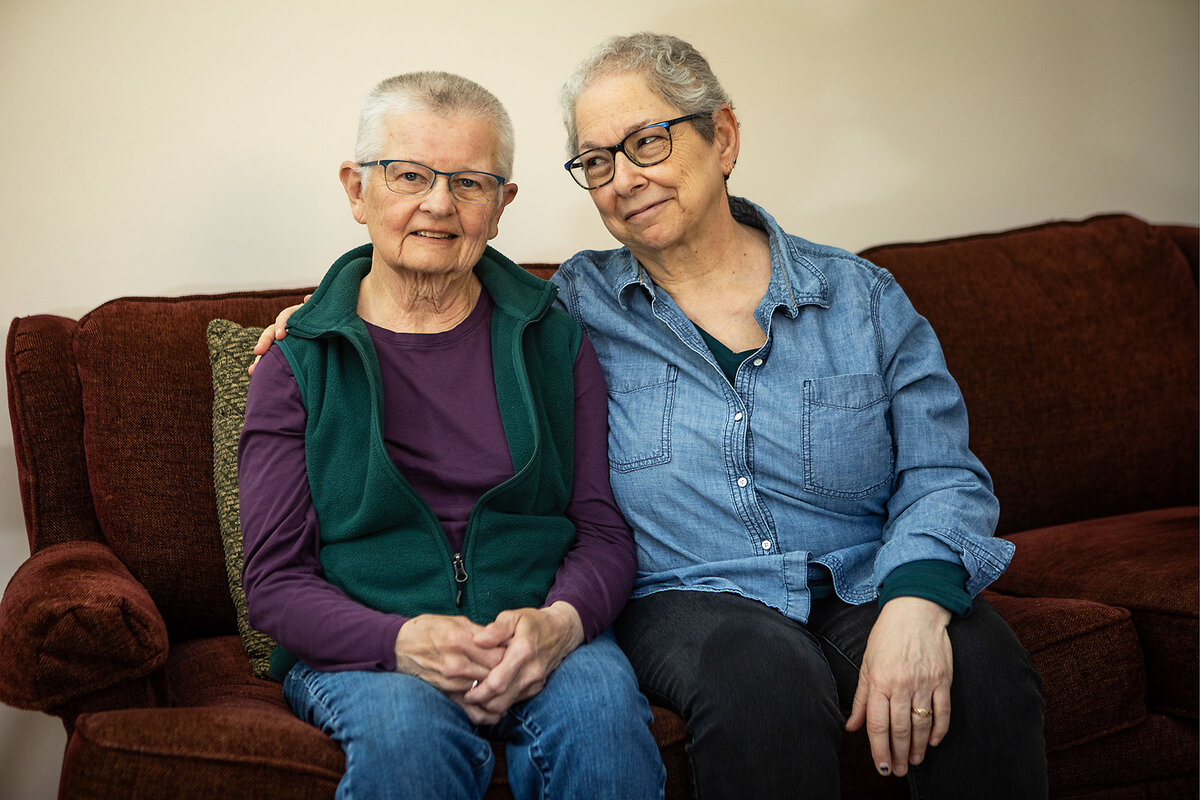Their weddings made history. Twenty years later, their love endures.
Loading...
| Boston and Cambridge, Mass.
When Heidi and Gina Nortonsmith fought the state of Massachusetts for their right to marry in the early 2000s, they fought as a family.
As plaintiffs in what would become a historic case, the two mothers waited at home every morning for months, anticipating news of a decision. A bag packed with clothes for their two sons, Avery and Quinn, stood ready if a drive from Northampton to Boston for a press conference would be necessary.
The parents were one of seven same-sex couples suing the state in Goodridge v. Department of Public Health, a case that had been making its way through the Massachusetts court system since 2001. A Superior Court judge had ruled against the group in 2002. On a November morning in 2003, the long-awaited phone call about an appeal arrived.
Why We Wrote This
A story focused onFriday marks the 20th anniversary of the first same-sex marriages in the United States. Two Massachusetts couples reflect on how they felt at the time – and on what marriage equality has meant to them since.
“It was a frantic couple of hours just trying to wrap our brains around what we needed to do to drive to Boston for a week with two young boys,” Gina recalls over Zoom. “We still didn’t know what the decision was. We just knew it was coming that day.”
The family was still on the road when the decision came down around 10 a.m. From a local radio station, they learned that the Massachusetts Supreme Judicial Court had ruled in their favor – making the state the first in the United States to allow same-sex marriage. Heidi and Gina planned to wed the first day it would be allowed, May 17, 2004.
Massachusetts couples like Heidi and Gina, who are celebrating their 20th anniversaries this month, say the court’s decision ignited the nationwide fight to legalize same-sex marriage. Eventually, the U.S. Supreme Court would agree, declaring state bans unconstitutional in 2015. But it was the Bay State that first afforded legal protections to spouses and families. Along with long-fought-for nuptials, couples also got a sense of stability.
“It created a kind of security and safety for people that we didn’t used to have,” says Mary Ann Kowalski, who wed her partner, Aren Stone, in Cambridge, Massachusetts, in the first wave of marriages.
“Being fully yourself in life”
After getting a marriage license from Northampton City Hall, Heidi and Gina tied the knot 20 years ago this Friday in a nearby park with their sons and close friends. They combined their individual surnames, Norton and Smith, which they engraved on silver bracelets for each member of the family, along with the date.
“When our sons were born, we chose the name Nortonsmith for them. So we tell them that they came out as Nortonsmith, but we had to earn it,” Gina says.
Before they were legally able to wed, Heidi and Gina had started a family and were looking for legal protections to raise their children. But they quickly found there weren’t many for same-sex couples. In the case of an emergency, only one parent, Heidi, who had carried the children, would be recognized.
“The law would consider Gina and our kids to be legal strangers. That was just really terrifying,” Heidi says. That’s when the couple joined the Goodridge case in 2001 to change the law.
Marriage equality extended various legal protections to same-sex parents, such as the right to make medical decisions for their children, and access to family leave benefits and inheritance rights.
The decision to issue marriage licenses for same-sex couples in 2004 was historic for both spouses and families. A 2004 Boston Globe survey found that half of the couples who applied for licenses on the first day had been partners for at least a decade. Of those, 30% had children. Two-thirds of the applicants were women.
“You can’t overstate the importance of being fully yourself in your life,” Heidi says. “Once Gina and I were married, and we could say wife or spouse, people knew what that was. Everybody had the same frame of reference for what that relationship is and how you treat it.”
“We worked really hard for it,” Gina adds, referring to the right to marry. “There are still people who are unhappy about it and who are doing their darndest to get rid of it.”
Hope for the future
In 2004, the atmosphere surrounding marriage equality in Massachusetts was a mix of excitement, controversy, and significant social change. For many, the legalization of same-sex marriages was an emotional moment and a rallying call for national awareness.
Ms. Stone, Ms. Kowalski’s wife, who sat on the Cambridge LGBTQ+ Commission for 10 years, says that with marriage equality, she could feel a little more comfortable and protected. But she says the debate in the state Legislature, which turned “ugly” at times, also educated the public about the ongoing struggles for same-sex couples.
“It just became so clear during all those legislative hearings how important it was. That if we lost, it would be a huge loss because we were not being seen as fully human,” Ms. Stone says, describing the debate that went on as the logistics of the law were hashed out.
“I think straight couples could see and understand what it’s like for gay people sometimes when they’re not accepted,” she adds.
Today, the first couples to wed 20 years ago are rooting for the next generation of LGBTQ+ young people, who can wed as they choose, but are fighting battles for different rights and protections. They also see some growth in cultural acceptance.
“Now people just talk about their husbands and wives just casually in movies,” Gina notes. “That’s a huge difference. It’s like it’s not even anything to remark upon. It’s just emblematic of how ingrained it is in society and how people understand that that’s an option everywhere.”
She observes that the things that felt impossible two decades ago, are now possible.
“It’s important to mark the 20th anniversary and to celebrate it,” she says, “because it helps bring hope for the other work that is yet to be done.”









